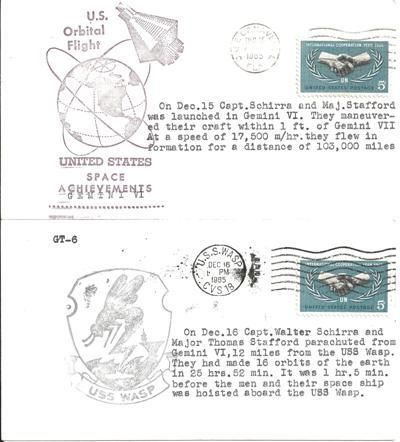Space Cover #255: Parachutes and Gemini 6AAn interesting aspect of early space cover collectors is that many of them added their own wording by typing a description of the event onto the cover. Many times this was a description from the NASA Aeronautics and Astronautics (A&A) yearbook series. Others used their own references or knowledge to add this wording.
Many times serviced events for say a Pershing or Minuteman launch could be changed into a Project Mercury or Project Gemini cover by "converting" it by typing an event description on the cover. These sell at a premium over the Pershing or Minuteman cover of the same date.
I really like to read the descriptions on the covers not quoting a source like A&A to see how they described the event. The covers above show an insight into why...
The first cover sounds great... "On Dec.15 Capt. Schirra and Maj. Stafford was launched in Gemini VI. They maneuvered their craft within 1 ft. of Gemini VII At a speed of 17,500 m/hr they flew in formation for a distance of 103,000 miles"
As the spacecraft approached each other the two spacecraft were only 130 feet apart. The maneuvering burns had only used 110 pounds of fuel on Gemini 6A, leaving plenty of fuel for the rendezvous. During the next 270 minutes the crews moved as close as 1 foot, talking over the radio. At one stage the spacecraft were in formation so well that neither crew had to make any burns for 20 minutes. As the sleep periods approached, Gemini 6A made a separation burn and slowly drifted out to 16 kilometers, to prevent an accidental collision in the night.
The second cover sounds good too... "On Dec.16 Capt. Walter Schirra and Major Thomas Stafford parachuted from Gemini VI. 12 miles from the USS Wasp. They had made 16 orbits of the earth in 25 hrs. 52min. It was 1 hr. 5min. before the men and their space ship was hoisted aboard the USS Wasp."
This is the only account I have seen of the Gemini 6A astronauts parachuting from their capsule 12 miles from the USS Wasp …. Interesting reading and perspective from a collector from that time period.
So the next time you see a cover where a collector has typed their own version of the event check it out in detail, you may find a completely different perspective than you thought you would.













